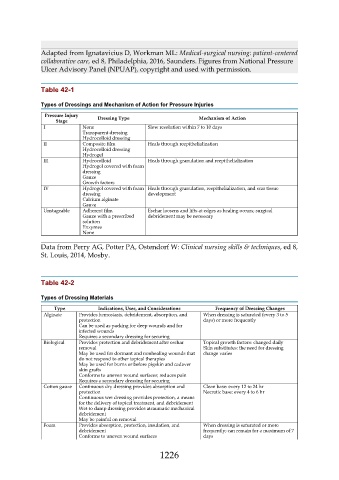Page 1226 - Saunders Comprehensive Review For NCLEX-RN
P. 1226
Adapted from Ignatavicius D, Workman ML: Medical-surgical nursing: patient-centered
collaborative care, ed 8, Philadelphia, 2016, Saunders. Figures from National Pressure
Ulcer Advisory Panel (NPUAP), copyright and used with permission.
Table 42-1
Types of Dressings and Mechanism of Action for Pressure Injuries
Pressure Injury Dressing Type Mechanism of Action
Stage
I None Slow resolution within 7 to 10 days
Transparent dressing
Hydrocolloid dressing
II Composite film Heals through reepithelialization
Hydrocolloid dressing
Hydrogel
III Hydrocolloid Heals through granulation and reepithelialization
Hydrogel covered with foam
dressing
Gauze
Growth factors
IV Hydrogel covered with foam Heals through granulation, reepithelialization, and scar tissue
dressing development
Calcium alginate
Gauze
Unstageable Adherent film Eschar loosens and lifts at edges as healing occurs; surgical
Gauze with a prescribed debridement may be necessary
solution
Enzymes
None
Data from Perry AG, Potter PA, Ostendorf W: Clinical nursing skills & techniques, ed 8,
St. Louis, 2014, Mosby.
Table 42-2
Types of Dressing Materials
Type Indications, Uses, and Considerations Frequency of Dressing Changes
Alginate Provides hemostasis, debridement, absorption, and When dressing is saturated (every 3 to 5
protection days) or more frequently
Can be used as packing for deep wounds and for
infected wounds
Requires a secondary dressing for securing
Biological Provides protection and debridement after eschar Topical growth factors: changed daily
removal Skin substitutes: the need for dressing
May be used for dormant and nonhealing wounds that change varies
do not respond to other topical therapies
May be used for burns or before pigskin and cadaver
skin grafts
Conforms to uneven wound surfaces; reduces pain
Requires a secondary dressing for securing
Cotton gauze Continuous dry dressing provides absorption and Clean base: every 12 to 24 hr
protection Necrotic base: every 4 to 6 hr
Continuous wet dressing provides protection, a means
for the delivery of topical treatment, and debridement
Wet to damp dressing provides atraumatic mechanical
debridement
May be painful on removal
Foam Provides absorption, protection, insulation, and When dressing is saturated or more
debridement frequently; can remain for a maximum of 7
Conforms to uneven wound surfaces days
1226

